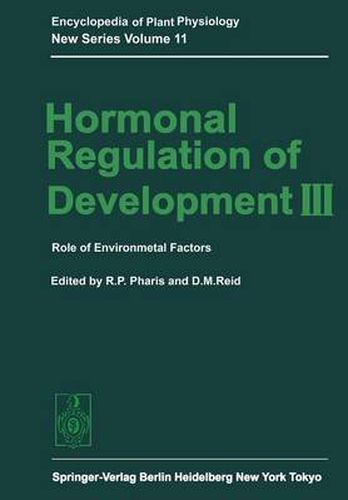Readings Newsletter
Become a Readings Member to make your shopping experience even easier.
Sign in or sign up for free!
You’re not far away from qualifying for FREE standard shipping within Australia
You’ve qualified for FREE standard shipping within Australia
The cart is loading…






This title is printed to order. This book may have been self-published. If so, we cannot guarantee the quality of the content. In the main most books will have gone through the editing process however some may not. We therefore suggest that you be aware of this before ordering this book. If in doubt check either the author or publisher’s details as we are unable to accept any returns unless they are faulty. Please contact us if you have any questions.
R. P. PHARIS and D. M. REID The idea of a separate Encydopedia volume dealing with the interrelations of plant hormones with factors in the environment of the plant, and its organs and tissues originated with N. P. KEFFORD, and we are most appreciative of the help and advice provided by Prof. KEFFORD in the formative stages of this volume. We have thus interpreted environment very broadly to indude not only factors external to the plant, e. g. , gravity, light, temperature, wind, mechanieal wounding, water, organism s (induding pollen), and magnetic and electric stimuli, but internaI factors as well (e. g. , nutrients, both inorganic and photoassimilate, direction, and time). In our definition of hormonaI effect , or hormonaI involvement , we have asked our authors to take a broad ap proach, and to examine not only phenomena that are mediated by the known plant hormones, but to discuss as well a wide variety of processes and events where hormonal involvement is implied through more indirect analyses and observations. The volume begins with environmental factors internaI to the plant; R. J. WEAVER and J. O. JOHNSON thus examine hormones and nutrients , their inter relationship in movement, accumulation, and diversion. As one studies a plant during its rapid growth phase, and later as maturation and aging proceed, it becomes apparent that time is an environmental cue of great significance, one which may exert a major influence via hormonal messages.
$9.00 standard shipping within Australia
FREE standard shipping within Australia for orders over $100.00
Express & International shipping calculated at checkout
This title is printed to order. This book may have been self-published. If so, we cannot guarantee the quality of the content. In the main most books will have gone through the editing process however some may not. We therefore suggest that you be aware of this before ordering this book. If in doubt check either the author or publisher’s details as we are unable to accept any returns unless they are faulty. Please contact us if you have any questions.
R. P. PHARIS and D. M. REID The idea of a separate Encydopedia volume dealing with the interrelations of plant hormones with factors in the environment of the plant, and its organs and tissues originated with N. P. KEFFORD, and we are most appreciative of the help and advice provided by Prof. KEFFORD in the formative stages of this volume. We have thus interpreted environment very broadly to indude not only factors external to the plant, e. g. , gravity, light, temperature, wind, mechanieal wounding, water, organism s (induding pollen), and magnetic and electric stimuli, but internaI factors as well (e. g. , nutrients, both inorganic and photoassimilate, direction, and time). In our definition of hormonaI effect , or hormonaI involvement , we have asked our authors to take a broad ap proach, and to examine not only phenomena that are mediated by the known plant hormones, but to discuss as well a wide variety of processes and events where hormonal involvement is implied through more indirect analyses and observations. The volume begins with environmental factors internaI to the plant; R. J. WEAVER and J. O. JOHNSON thus examine hormones and nutrients , their inter relationship in movement, accumulation, and diversion. As one studies a plant during its rapid growth phase, and later as maturation and aging proceed, it becomes apparent that time is an environmental cue of great significance, one which may exert a major influence via hormonal messages.